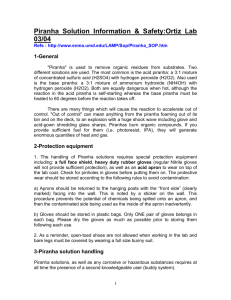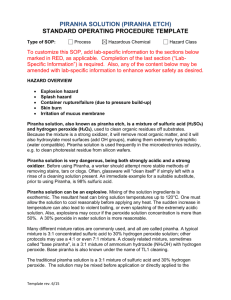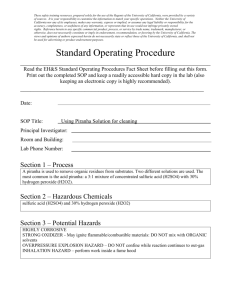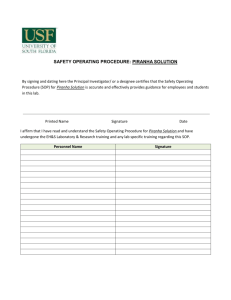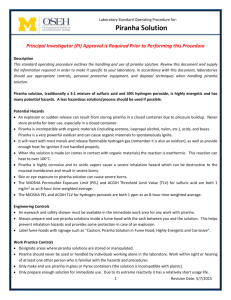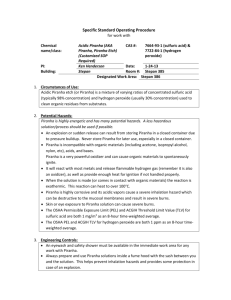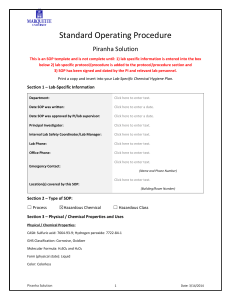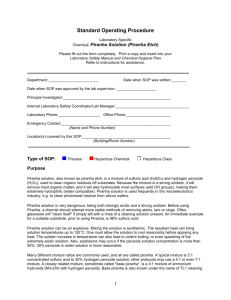Piranha Solution
advertisement
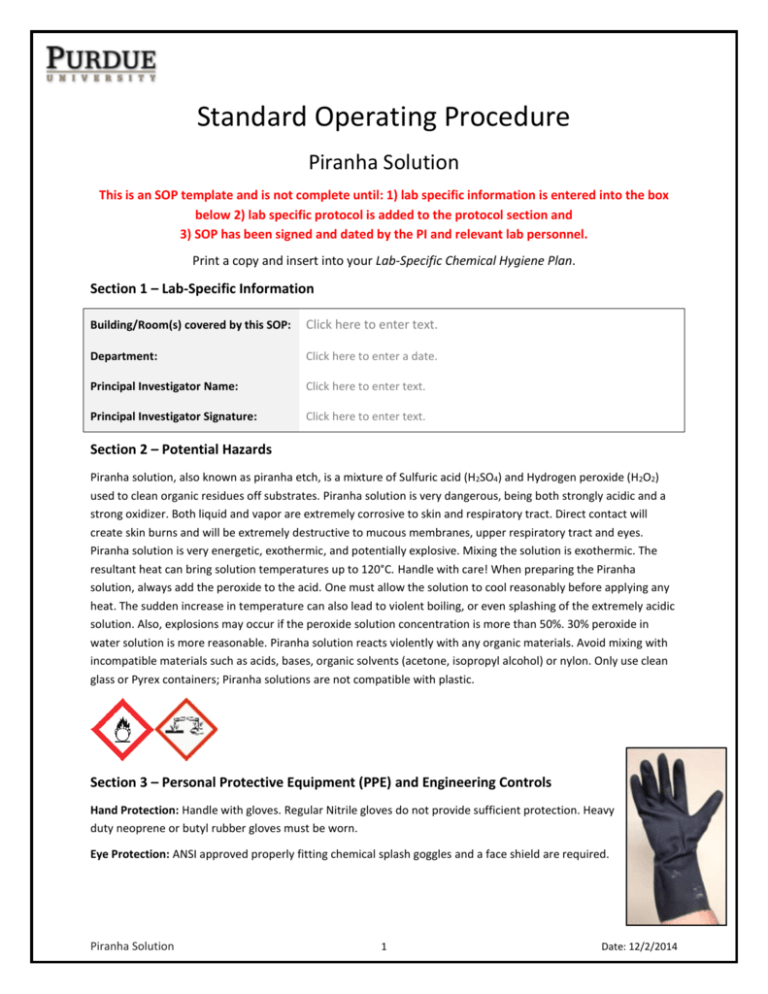
Standard Operating Procedure Piranha Solution This is an SOP template and is not complete until: 1) lab specific information is entered into the box below 2) lab specific protocol is added to the protocol section and 3) SOP has been signed and dated by the PI and relevant lab personnel. Print a copy and insert into your Lab-Specific Chemical Hygiene Plan. Section 1 – Lab-Specific Information Building/Room(s) covered by this SOP: Click here to enter text. Department: Click here to enter a date. Principal Investigator Name: Click here to enter text. Principal Investigator Signature: Click here to enter text. Section 2 – Potential Hazards Piranha solution, also known as piranha etch, is a mixture of Sulfuric acid (H2SO4) and Hydrogen peroxide (H2O2) used to clean organic residues off substrates. Piranha solution is very dangerous, being both strongly acidic and a strong oxidizer. Both liquid and vapor are extremely corrosive to skin and respiratory tract. Direct contact will create skin burns and will be extremely destructive to mucous membranes, upper respiratory tract and eyes. Piranha solution is very energetic, exothermic, and potentially explosive. Mixing the solution is exothermic. The resultant heat can bring solution temperatures up to 120°C. Handle with care! When preparing the Piranha solution, always add the peroxide to the acid. One must allow the solution to cool reasonably before applying any heat. The sudden increase in temperature can also lead to violent boiling, or even splashing of the extremely acidic solution. Also, explosions may occur if the peroxide solution concentration is more than 50%. 30% peroxide in water solution is more reasonable. Piranha solution reacts violently with any organic materials. Avoid mixing with incompatible materials such as acids, bases, organic solvents (acetone, isopropyl alcohol) or nylon. Only use clean glass or Pyrex containers; Piranha solutions are not compatible with plastic. Section 3 – Personal Protective Equipment (PPE) and Engineering Controls Hand Protection: Handle with gloves. Regular Nitrile gloves do not provide sufficient protection. Heavy duty neoprene or butyl rubber gloves must be worn. Eye Protection: ANSI approved properly fitting chemical splash goggles and a face shield are required. Piranha Solution 1 Date: 12/2/2014 Skin and Body Protection: Laboratory coats must be worn and be appropriately sized for the individual and buttoned to their full length. Additional protection such as acid-resistant apron may be appropriate as well. Personnel must also wear full length pants, or equivalent, and close-toed shoes. Full length pants and close-toed shoes must be worn at all times by all individuals that are occupying the laboratory area. The area of skin between the shoe and ankle must not be exposed. Respirator Protection: If piranha solutions are being used outside of a chemical fume hood, respiratory protection may be required. If this activity is absolutely necessary, contact REM (49-46371) so a respiratory protection analysis can be performed. Engineering Controls: If piranha solutions are being used outside of a chemical fume hood, respiratory protection may be required. If this activity is necessary, contact REM (49-46371) so a respiratory protection analysis can be performed. Hygiene Measures: Avoid contact with skin, eyes, and clothing. Wash hands before breaks and immediately after handling the product. Section 4 – Special Handling and Storage Requirements Before using Piranha solution, more stable methods of removing stains, tars, or clogs should be attempted. Often, glassware can be cleaned if left with a cleaning solution. An immediate example for a suitable substitute, prior to using Piranha, is 98% Sulfuric acid. A current copy of the Piranha solution components’ SDS must be made available to all personnel working in the laboratory at all times. Always use glass (preferably Pyrex) containers. Piranha will melt plastics. Piranha solution should be used freshly-prepared, due to the self-decomposition of hydrogen peroxide. Do not maintain a stock solution of the Piranha mixture. Prepare small amounts of solution to be used for each application. Mix the solution in a fume hood with the sash between you and the solution. The solution may be mixed before application or directly applied to the material, applying the Sulfuric acid first, followed by the peroxide. When preparing the piranha solution, always add the peroxide to the acid. Hydrogen peroxide concentrations should be kept below 30%, and should never exceed 50%. Piranha solution should never be left unattended if hot. Once finished, allow the hot piranha solution to cool in an open container. Once cooled down, neutralize the waste following the procedures detailed in Section 6 below. Never seal containers containing Piranha solution. Avoid using airtight containers as pressure can build up inside of them. Never store piranha solutions. Oxygen given off during the self-decomposition, as well as the oxidation products of organic compounds can cause the container to rupture. Mixing hot piranha with organic compounds may cause an explosion. This includes acetone, photoresist, isopropyl alcohol (other organic solvents), and nylon. Section 5 – Spill and Accident Procedures Immediately evacuate area and ensure others are aware of the spill. If there is an imminent threat of a fire, pull the nearest fire alarm station to evacuate the building and dial 911. If personnel have become exposed and need Piranha Solution 2 Date: 12/2/2014 medical assistance, dial 911. If the spill is minor and does not pose a threat to personnel, contact REM at 49-40121 during normal business hours (Monday – Friday, 7 AM – 4 PM) for spill cleanup assistance (dial 911 if spill occurs after hours and assistance is needed). Section 6 – Neutralization and Waste Disposal Procedures Due to several incidents involving container over pressurization, REM will not pick up piranha solution as hazardous waste. Piranha solution must be neutralized in the lab by lab personnel. To perform this procedure safely, place a beaker or bucket within a fume hood. Fill the bucket with cold tap water and ice. Don appropriate PPE (refer to Section 3). Slowly add waste piranha solution to the cold water beaker to dilute it. Reduce the hydrogen peroxide component of the piranha solution by adding sodium bisulfite. Potassium Iodide Starch Paper will indicate when the hydrogen peroxide has been reduced. Note: this is an exothermic reaction that generates sulfuric acid and should be done carefully. Once the hydrogen peroxide is reduced, slowly add sodium hydroxide or sodium bicarbonate or another appropriate inorganic base to bring the pH of the solution to a neutral range (pH 59). If there are no other hazardous contaminants (e.g., heavy metals, regulated organics) present in the solution, the neutralized solution can be poured down the drain. If regulated contaminants are still present (e.g., heavy metals, regulated organics, or if you are unsure), collect the neutralized solution as hazardous waste. Store the waste in a closed container, properly label the container listing the regulated constituents, and store in a designated area. Complete a Chemical Waste Pickup Request Form to arrange for disposal by REM; detailed instructions are provided at the following link: http://www.purdue.edu/ehps/rem/hmm/chemwaste.htm. Section 7 – Protocol (Additional lab protocol may be added here) Click here to enter text. NOTE: Any deviation from this SOP requires approval from Principal Investigator. Section 8 – Documentation of Training (signature of all users is required) Prior to conducting any work with piranha solution, the Principal Investigator must ensure that all laboratory personnel receive training on the content of this SOP. I have read and understand the content of this SOP: Name Signature Date Click here to enter text. Click here to enter a date. Click here to enter text. Click here to enter a date. Click here to enter text. Click here to enter a date. Piranha Solution 3 Date: 12/2/2014

